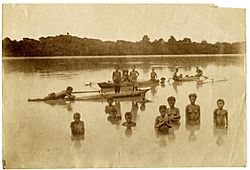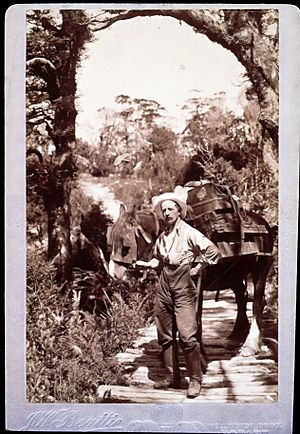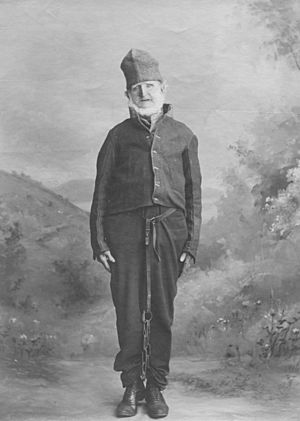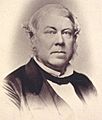John Watt Beattie facts for kids
Quick facts for kids
John Watt Beattie
|
|
|---|---|

John Watt Beattie in 1920
|
|
| Born | 15 August 1859 |
| Died | 24 June 1930 (aged 70) |
| Nationality | Australian |
| Education | autodidact |
| Known for | Landscape photography |
| Spouse(s) | Emily Cox Cato |
| Awards | 1890: Fellow, Royal Society of Tasmania; 1996: Photographer to the Government of Tasmania |
John Watt Beattie (born August 15, 1859 – died June 24, 1930) was a famous Australian photographer. He was known for his beautiful landscape photos of Tasmania and for documenting important historical moments.
Contents
Early Life and Move to Tasmania
John Beattie was born in Aberdeen, Scotland, on August 15, 1859. His parents were Esther Imlay and John Beattie. He went to grammar school. In 1878, when he was 19, John and his parents moved to Tasmania. They started a farm in the Derwent Valley.
John Beattie: The Photographer
John Beattie started taking photos in 1879. He became friends with another early photographer, Louisa Anne Meredith. She helped him learn more about photography. She also showed him old photos taken by Bishop Nixon.
Photos of Aboriginal People
Bishop Nixon had taken pictures of nine Oyster Cove Aboriginal people in 1858. John Beattie later made copies of these photos. He also copied portraits taken by Charles A. Woolley in 1866. These showed the last five surviving Aboriginal people from Oyster Cove. Famous individuals like Truganini and William Lanne were in these pictures. Beattie continued to print and share these important historical photos. He also made them into lantern slides for presentations.
Capturing Tasmania's Landscapes
In 1882, Beattie joined a photography business called Anson Bros. They were known for their scenic views. In 1891, he took over the business completely. He used their old photo negatives to make new prints, selling them under his own name.
John Beattie married Emily Cox in 1886. His photography business grew very large. It had exhibition rooms for landscapes and portraits. There were also darkrooms, a framing department, and even a lending library. He also created the Beattie Museum, which displayed old items from Tasmania.
Beattie loved nature and was a founding member of the Theosophy group in Hobart. He was inspired by painter William Pigeunit. Beattie's photos showed the beauty of Tasmania in a romantic style. He made prints, postcards, and lantern-slides from his pictures. In the 1880s and 1890s, he hiked to wild and rugged places. He carried heavy camera gear, sometimes weighing over 27 kilograms. He said he loved standing on high land and looking at the mountains.
Protecting Tasmania's Nature
Beattie took many photos across Tasmania, including the Central Highlands and the West Coast. He even worked for a mining company, North Mount Lyell, photographing areas like Gormanston and Kelly Basin.
Even though he worked for a mining company, Beattie cared about nature. He warned that some areas would become "bare desolate wastes" in a few years. He believed in both conservation and tourism. He sometimes moved plants like grass trees to make his photos look better.
Beattie also worked to protect places like the Gordon River. He spoke to the Royal Society in 1908 about saving Tasmania's beautiful scenery. He believed that protecting these natural attractions would help tourism. He thought people would care more if they saw how beautiful these places were.
Beattie used his photos to show the beauty of remote areas. He used new technology like photographic lantern slides to convince people to protect these places. This was a new way to promote conservation. He helped make Freycinet Peninsula a game sanctuary. His efforts were similar to later groups like the Hobart Walkers Club and the Wilderness Society.
Capturing People: Portraits
Besides landscapes, Beattie also took many studio portraits, especially when he was starting out. This helped him earn money. He kept up with new photography techniques.
In 1896, he became the "Photographer to the Government of Tasmania." This meant he photographed many important people in Tasmanian history. These included politicians, judges, religious leaders, and explorers. He even photographed a convict named Bill Thompson.
A Historian Through His Lens
Beattie loved history. He photographed the old ruins of the Port Arthur penal colony. In the 1890s, he opened a museum of art and historical items in Hobart. It later moved to his photography studio. Visitors paid a small fee to see the collection.
As the government photographer, he created photo collections of the Governors of Tasmania and Tasmanian Parliament members. He also promoted tourism by making and sharing lantern slide shows. These shows featured places like A trip through Tasmania and Port Arthur and Tasman Peninsula. His photos appeared in the 1900 Cyclopedia of Tasmania and later in Walkabout magazine. His pictures of Port Arthur were even used on postcards.
Beattie was a vice-president of the Royal Society of Tasmania's Historical Section. He gave lectures about early Tasmanian governors. He also suggested that Tasmania should create special stamps with scenic landscapes to promote the state. This idea was used, and several Tasmanian stamps featured his photographs.
Photography Beyond Australia

Like other photographers of his time, Beattie traveled to the Western Pacific to take photos.
In late 1906, he took 1500 photos during a trip on the Southern Cross ship. He was invited by Bishop Cecil Wilson to visit mission centers. He photographed places like Norfolk Island, the Solomons, and the New Hebrides.
In his diary, he wrote about taking photos in Ambae. He found that people were scared of his camera at first. He showed them the view of boats on the sea through the camera's ground glass. This made them happy and helped him gain their trust.
In 1912, Beattie developed the photo plates that Roald Amundsen used on the first trip to the South Pole. Sadly, a fire destroyed Beattie's studio, and Amundsen's negatives were lost. Only one original print from that trip survives today.
Later Life and Death
John Watt Beattie passed away suddenly from heart disease in Hobart on June 24, 1930. He was 70 years old. He was survived by his wife and two daughters. His cousins, Jack Cato and John Cato, also became important photographers.
Collections of His Work
After his death, some of Beattie's photo collection was bought by the Launceston Corporation. These photos are now kept at the Queen Victoria Museum. Some of his slides were given to the Tasmanian Museum in Hobart. The photography business he started continued to sell his work until 1978.
His Legacy
John Beattie's work helped people appreciate the natural world. His beautiful pictures of Tasmania's wilderness and Port Arthur helped people argue for protecting nature. These photos were important for promoting tourism in the late 1800s and early 1900s.
His cousin, the photographer and historian Jack Cato, greatly admired him. Cato called Beattie "the finest landscape photographer of his age."
See also
- Photography in Australia
Gallery of photographs by Beattie












